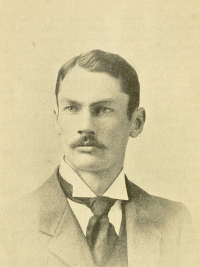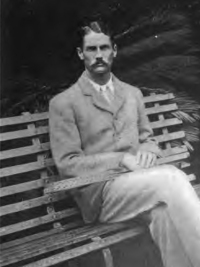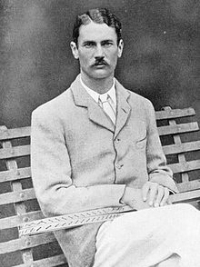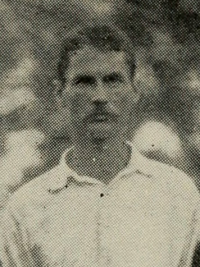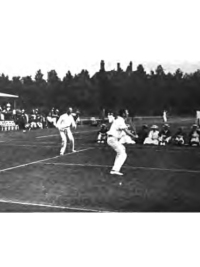Harold Mahony
Full name: Harold Segerson Mahony
Alias: Mahoney
Alias: Mahoney
| Born |
Subscribe now
This information and data is not available because you are not our subscriber yet.
Please click here and get full access to the entire database! |
|---|---|
| Died | |
| Height | |
| Weight | |
| Plays | |
| Bio | Numerous reference books and encyclopaedic websites state the plain fact that Mahony was born in Edinburgh, but others claim he was born in Ireland, in County Kerry. There is no record of him at the General Register Office for Scotland, despite there being a legal obligation from 1855 onwards for every birth in Scotland to be registered formally. Certainly, Mahony was raised as Irish rather than Scottish, and while the labeling of a landowner from County Kerry as a Scot may be a notional exercise - he only lived in Scotland as a young child - debate over his birthplace can now be resolved. Joyce House in Dublin accommodates the Irish registry of births, marriages and deaths. An entry made on 19 July, 1867 details that one Harald Segerson Mahony was born on 21 February of that year at 21 Charlotte Square, Edinburgh. His parents were Richard John Mahony, a barrister and justice of the peace, of Dromore Castle in the district of Kenmare, County Kerry, and his wife, Mary Harriette Mahony, nee Waller. Two years later, presumably dividing their time between Ireland and Scotland, the couple had a second child in Edinburgh, this time registered locally. Hardress Waller Mahony was born at Dalmore Lodge in Leith - the family's residence in Scotland - on 3 July, 1869. However, the baby died 18 days later at the same address. The Mahonys only had one other child, Norah. There is no clear indication of why the family spent so much time in Scotland in preference to their Irish castle, which Richard had inherited from his father, Rev Denis Mahony, in 1851. Harold's father ran the Dromore estate and farmed oysters in the bay, and in 1872 he was listed as the sixth-biggest landowner in Ireland. Harold, already a tennis player of some note who had a court installed in the castle grounds which remains today, inherited the deeds in 1892, aged 25. Within four years of becoming a landed proprietor, and still shy of his 30th birthday, Mahony joined a growing list of Irish gentry to win Wimbledon, the world's most prestigious tennis tournament, at his sixth attempt. He defeated Wilfred Baddeley 6-2, 6-8, 5-7, 8-6, 6-3 in the challenge round, as the final match was known, of the men's singles. The 57-game epic was a record for the Wimbledon final and lasted until 1954 when Jaroslav Drobny beat Ken Rosewall for the title in 58 games. And unwittingly, he set a standard that generations of Scots-born tennis enthusiasts could not emulate. In his monumental 1,800-page, three-volume tome, The History of Irish Tennis, Tom Higgins writes that Mahony "excelled at the volleying game, his great length of limb combined with exceptional alertness and activity, making it very hard for his opponents to pass him after he has once worked his way to the net". Insight into Mahony's personality is more intriguing still, evoking comparisons with his fellow Trinity College alumni, Oscar Wilde. "He also was described as a charming, devil may care personality," writes Higgins. "He was a witty talker and accomplished musician and entertained lavishly in the house he kept at Earls Court in London. "It is not surprising, therefore, that he played in the Wimbledon Championships more often than most, if not all, Irish men or women. His looks and charm were much sought after by ladies looking for coaching." Indeed, pictorial evidence of Mahony's popularity with the opposite sex is carried in Heiner Gillmeister's book Tennis: A Cultural History. Mahony spoke fluent German and competed frequently in that country, and a caption in Gillmeister's book reads: "This photograph proves that Harold S. Mahony had the reputation of being a ladies' man." Mahony sits astride one lady in whites on his right, and four more on his right. The other highlight of Mahony's tennis career came at the 1900 Olympics in Paris, when he won three medals, and in 1898 when he beat Joshua Pim in the final of the German Championships. In Paris, he began with a bronze medal alongside Britain's Arthur Norris and added a mixed-doubles silver on behalf of an International Team alongside Helene Provost, before losing the men's singles final to Hugh Doherty. Dividing his time between Dromore, London and Germany, he continued to compete at Wimbledon but, ahead of the 1905 championships, tragedy struck. Out cycling on June 27 in the neighbouring district of Killarney, Mahony fell from his bike at the foot of Caragh Hill, near Killorglin. His death was recorded on 3 October, with the cause described as: "Fall from a bicycle. Ten minutes no medical attendant." Staff at Joyce House admitted this was a curious entry, as most registered deaths described the precise injury that proved fatal. Mahony was mourned in Ireland, London and Germany, where he made front page news and inspired a tribute in the daily Sport im Bild. (Source: Tom Higgins: The history of Irish tennis) |
| Misc | Subscribe now |
| Tournament | AO | RG | W | US | Win-Loss |
|---|---|---|---|---|---|
|
Subscribe now
This information and data is not available because you are not our subscriber yet.
Please click here and get full access to the entire database! |
|||||
